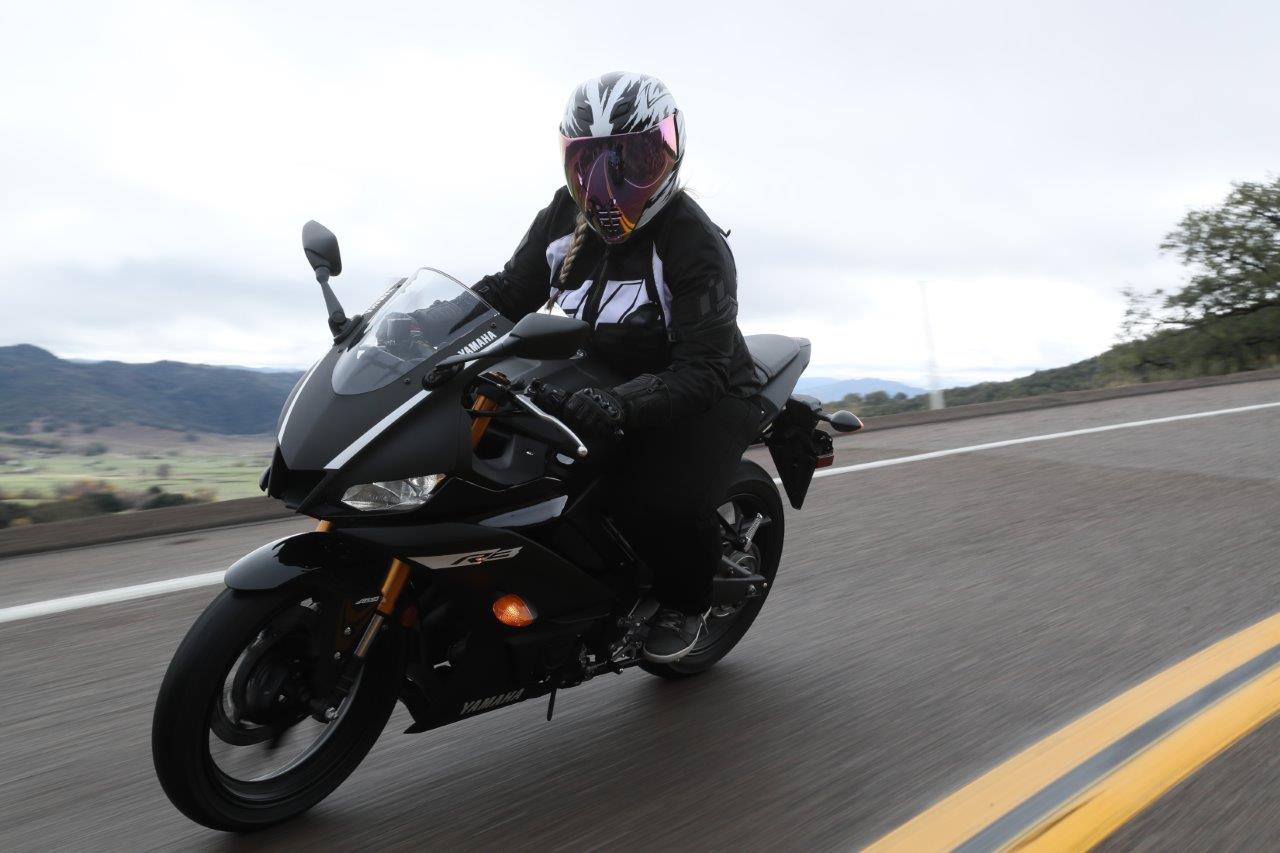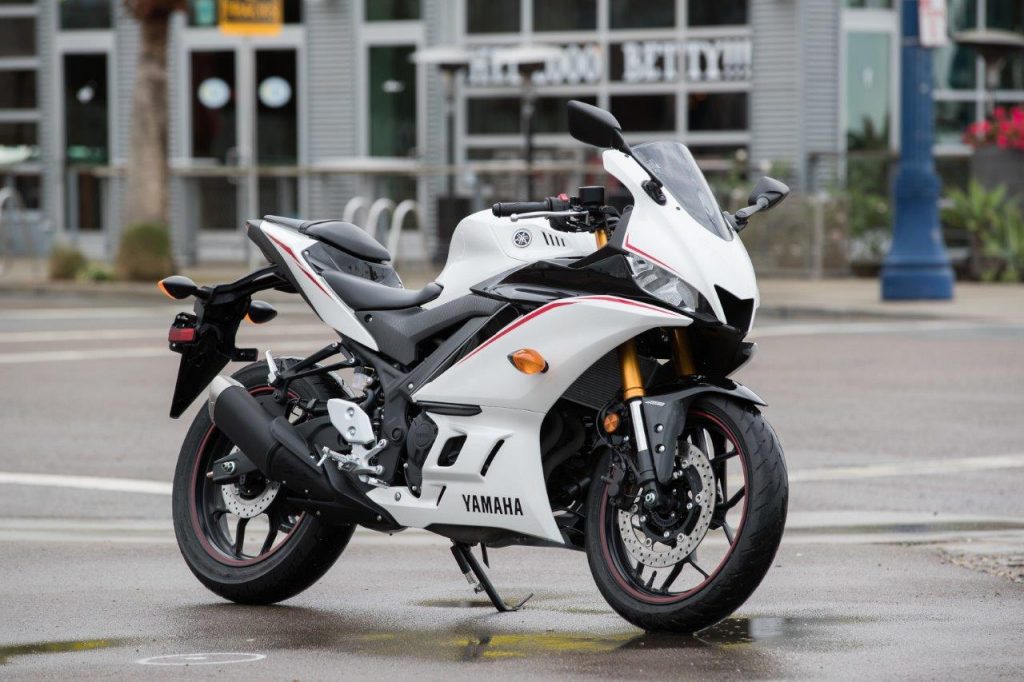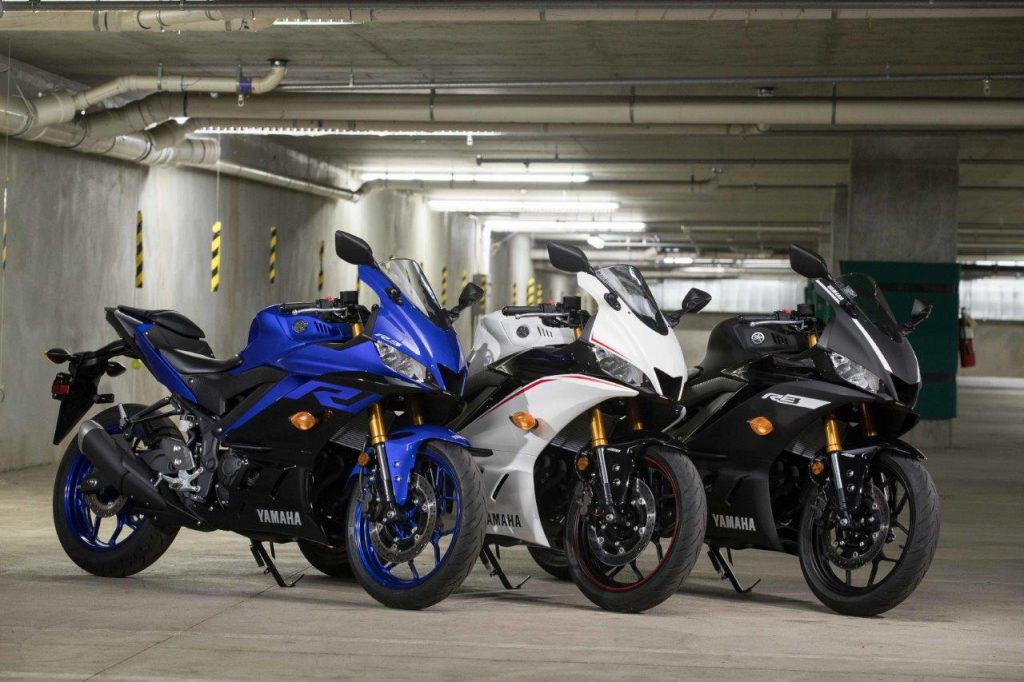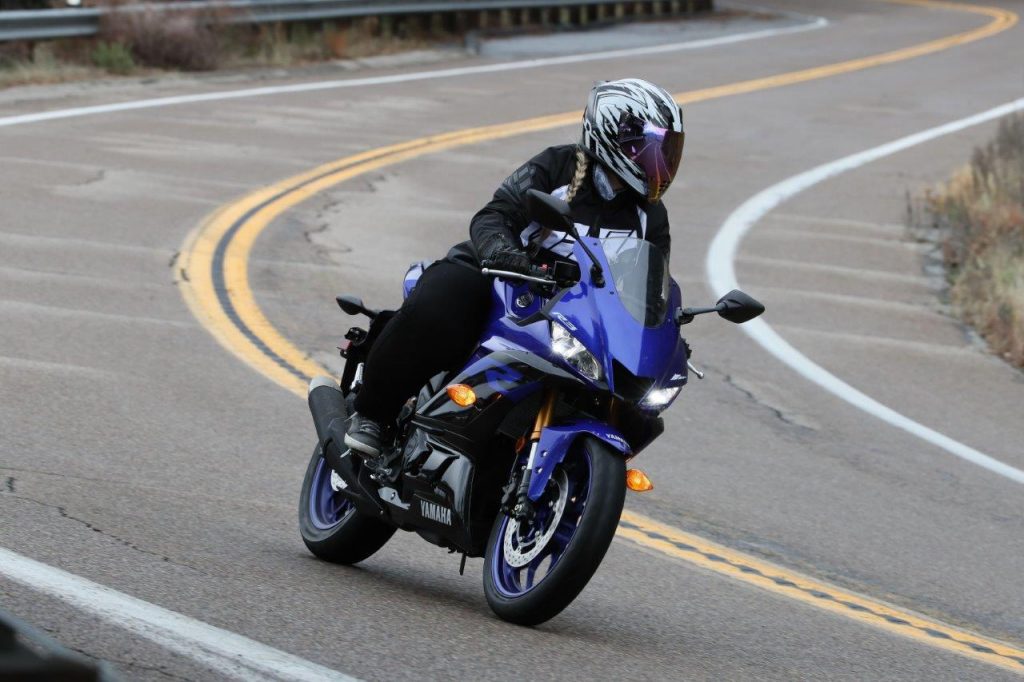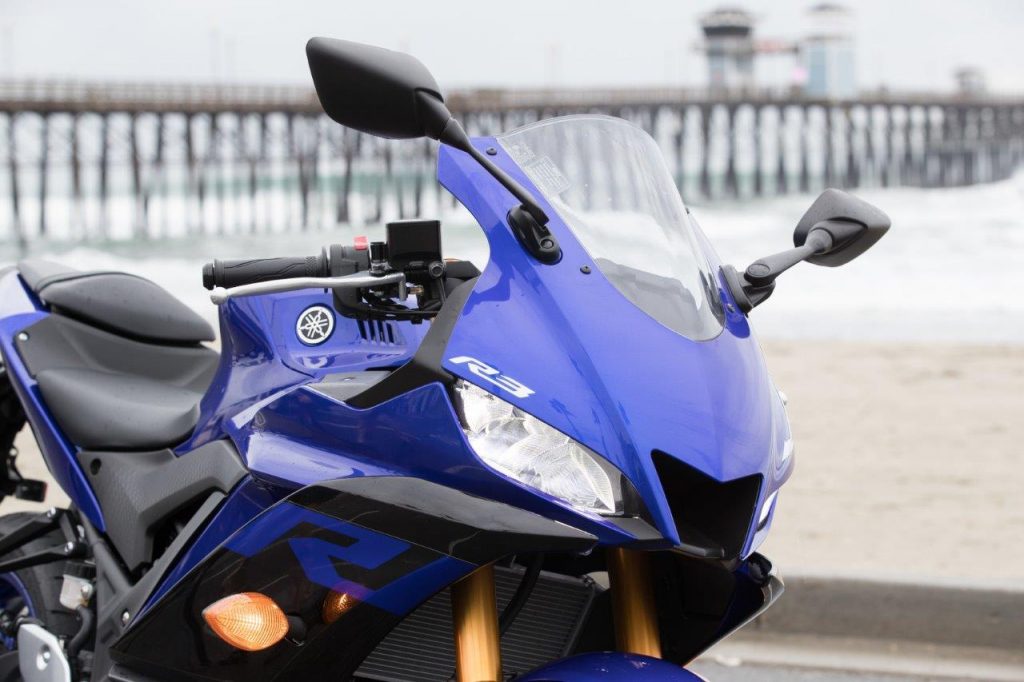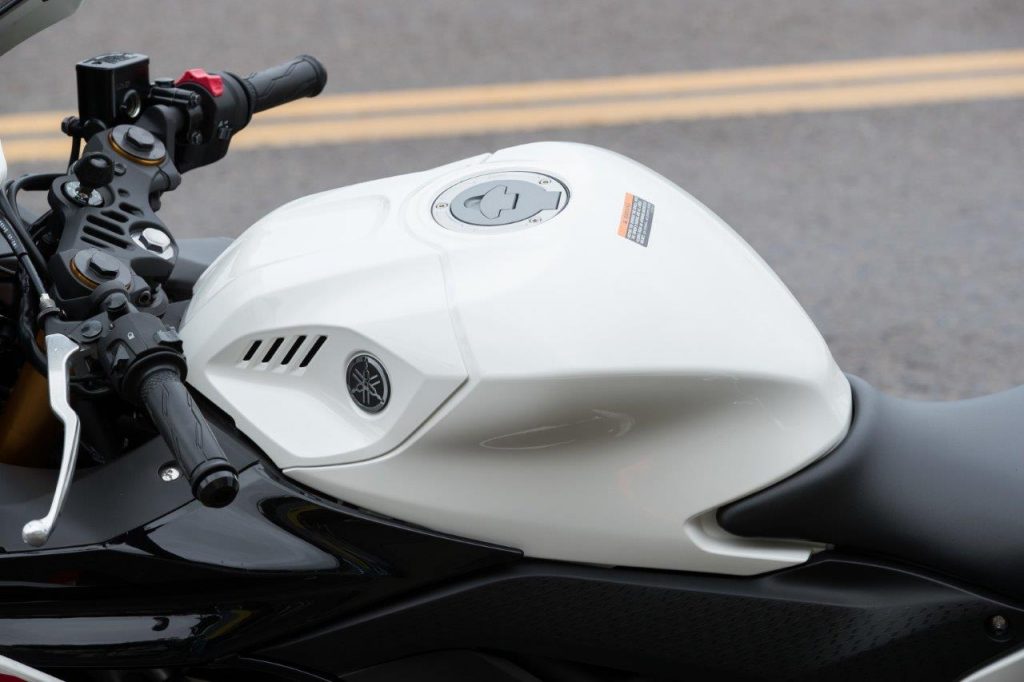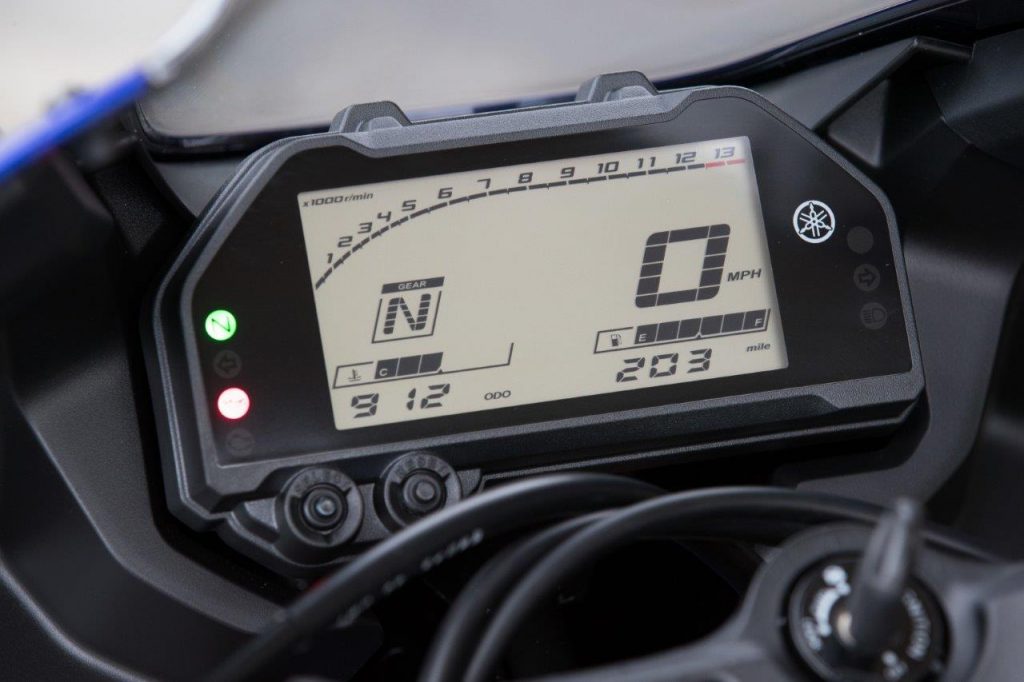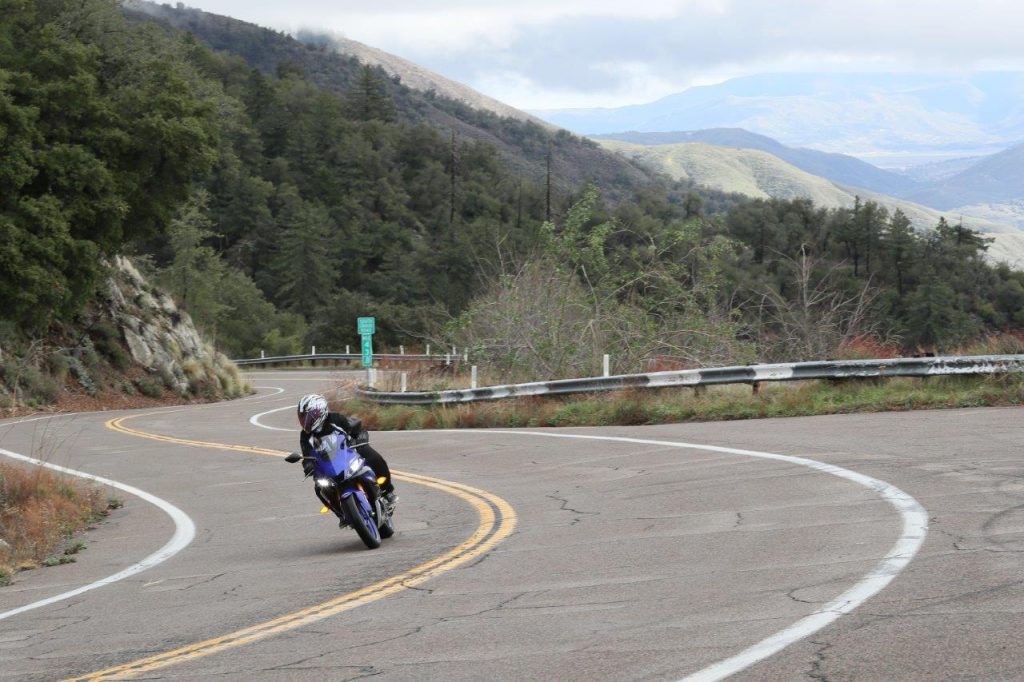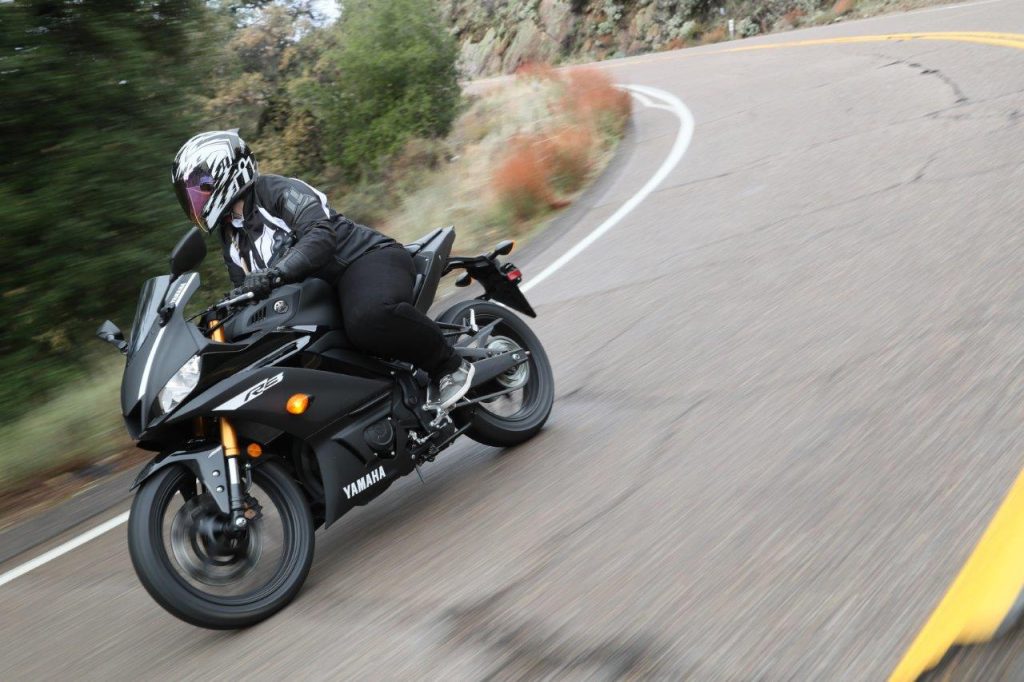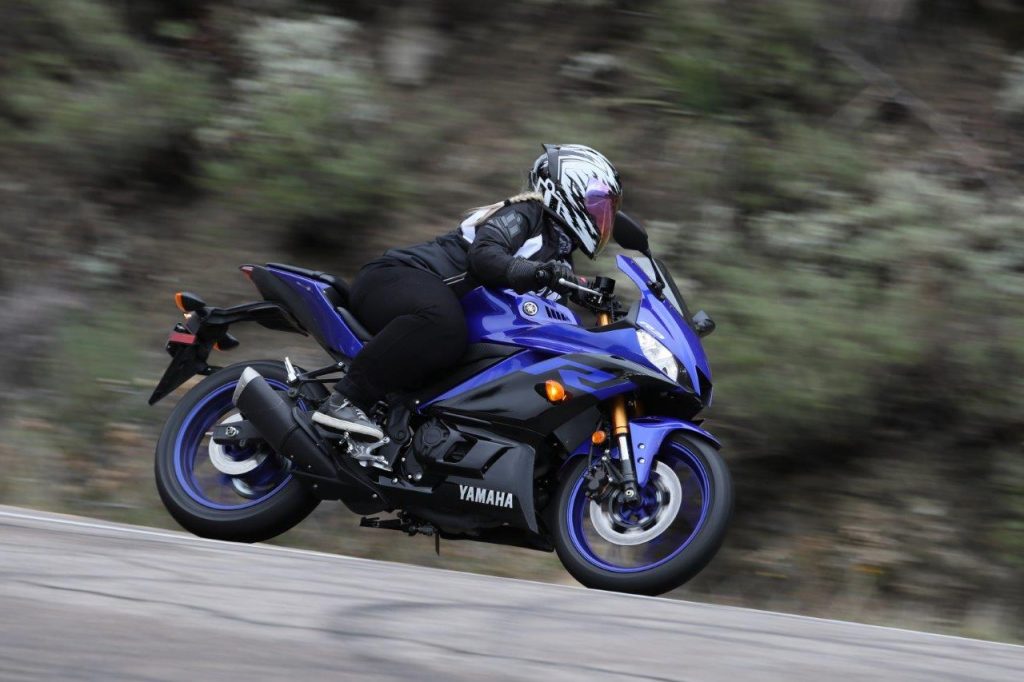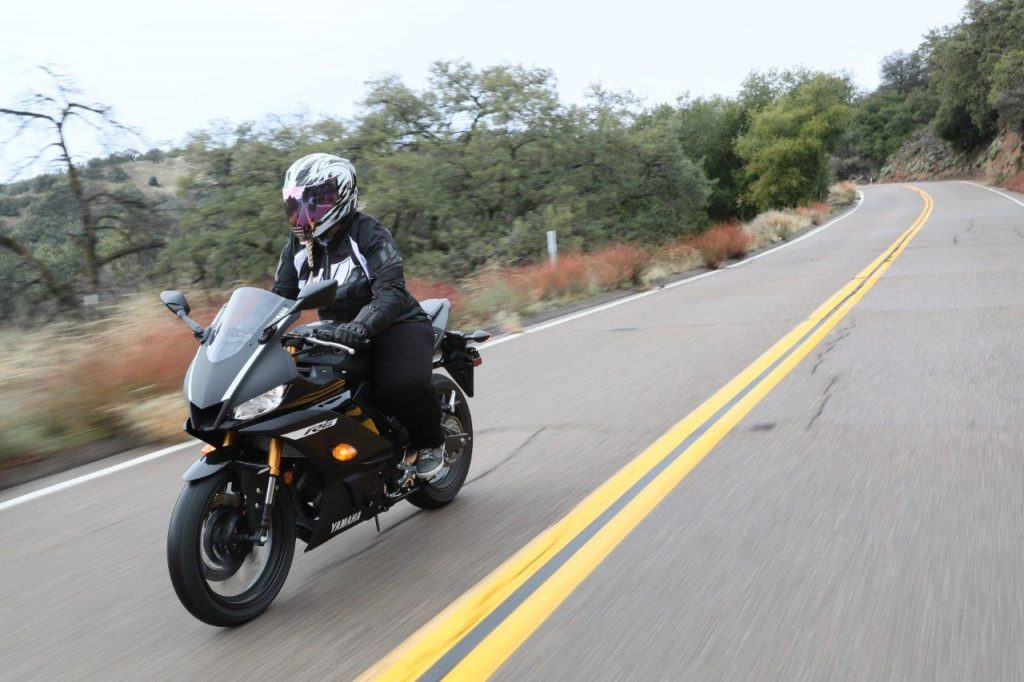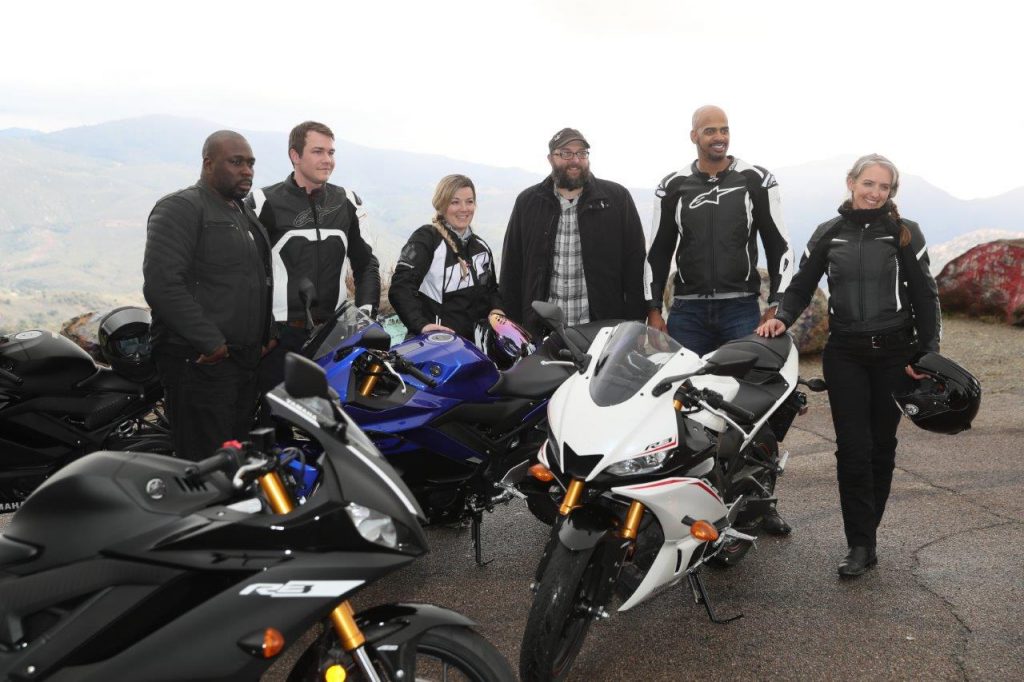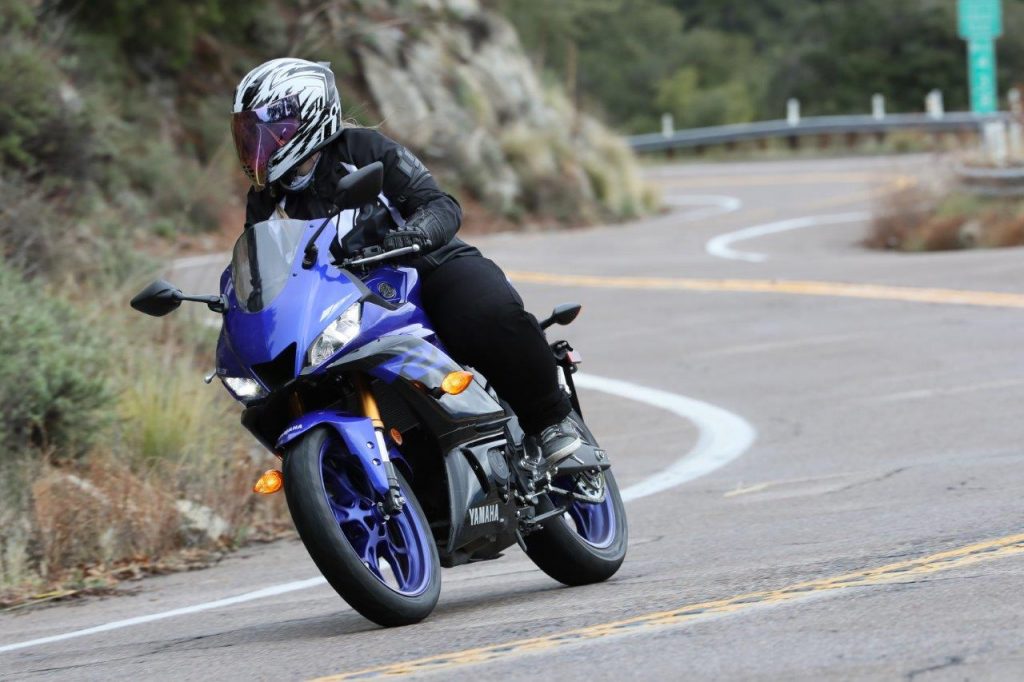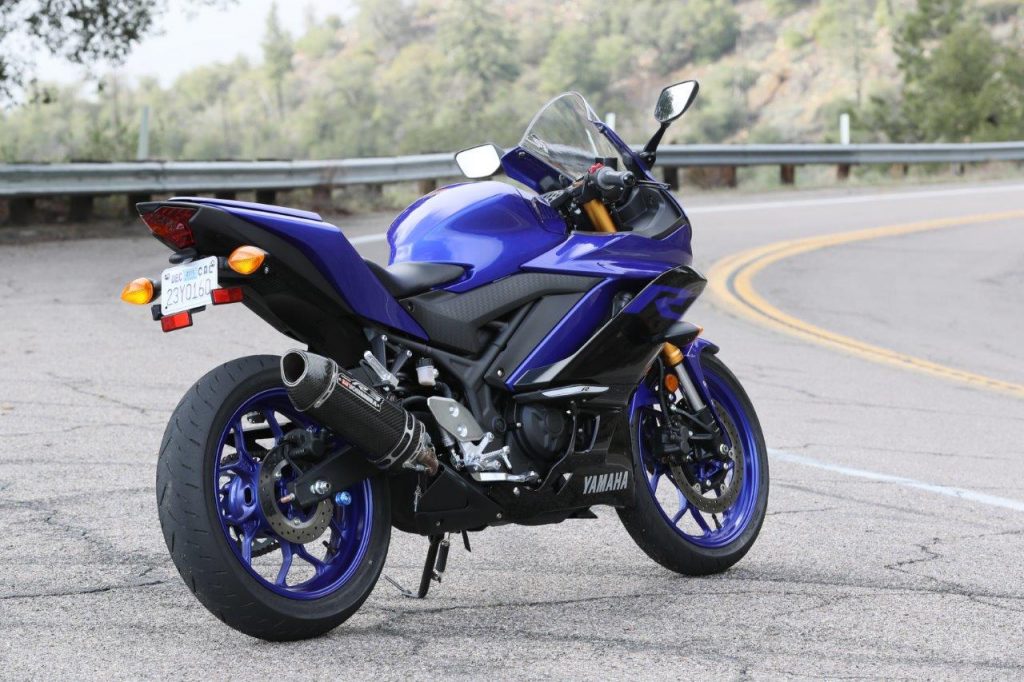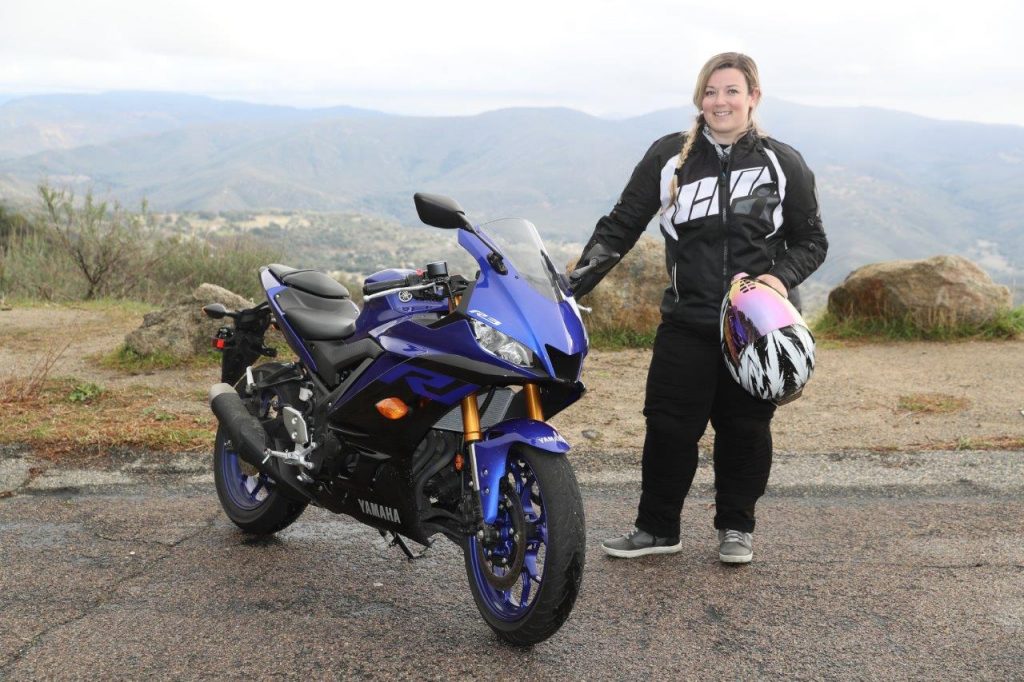First Impressions
I got my first look at the new 2019 YZF-R3 in Las Vegas, Nevada, at the AIMExpo in October of 2018. It was love at first sight. I immediately noticed the aggressively placed clip-ons, MotoGP-esque front faring, and more angular gas tank. The new styling so closely resembles it’s “big brothers” (the YZFR1M, YZFR1, and YZFR6) that it makes the R3 a true “younger sibling” as far as looks are concerned. In my opinion, barring the R3 logo, an unknowing passerby would be hard pressed to pick out the baby of the bunch.
Of course, no first look is complete without a test-sit. I spent at least 15 minutes on the R3 trying my best to find something I didn’t like about it. Resistance is futile. Without the chance to ride it, I had to walk away with only hope and dreams involving the performance upgrades Yamaha had promised. You can read about the full technical overhaul here.
The Predecessor: 2015 Yamaha YZFR3
To preface, I own a 2015 YZFR3. Let me tell you about mine (I call mine “Threezy”).
The R3 has undoubtedly been a great all-around machine since it was introduced in 2015. So great, in fact, that it’s Yamaha’s best-selling bike in the current lineup. They’ve sold 20,000 units since its introduction. Why? It’s easy to turn and manipulate, the power is predictable, and the bike is extremely comfortable. You can choose to ride as aggressive or docile as you wish and the R3 takes it all in stride, even as a first bike for beginner riders.
Room for Improvement
The area where I wished to see the most improvement: suspension. My R3 is just a little “squishy” under braking and “bouncy” on rutted road surfaces. Adjusting the rear shock helped, but it is still far from ideal. Without adjustable forks, I was stuck with stock compression and rebound settings, and I find that my front end sinks and dives under heavy braking.
For a new rider who is still learning lever finesse, an unbalanced bike could lead to problems. Rightfully so, my expectations in the suspension department were quite high when I heard Yamaha was rolling out an updated model four years later.
Design Features
Fairings
The R3 got a facelift and got it right. The “M” shape between the headlights is a direct snag from the M1, which first trickled down to the R1 and the R6. I was so happy to see the R3 finally join the elevated design club. Paired with a molded windscreen, the front faring looks like a single piece, closely resembling a race fairing.
The new tail and tank shape is also reminiscent of the larger Rs, with more concentration on aerodynamics, which gives the bike the look of a true supersport.
Tank
With a lower, flatter top, and an aggressive cut-in for the knees, the tank feels like it’s meant for planting your outside leg mid-corner. Perhaps that was the exact intention. The tank shape of the new R3 also looks much more race-oriented than its predecessor.
All of this without losing an ounce of capacity, 3.7 gallons to be exact. At 56mpg on average, you could easily ride for several hours without having to fill up or ride to and from work for a week as long as your commute is less than 40 miles round-trip.
Dash
The new streamlined digital dash is simple and easy to read. It more closely resembles the simplicity of the M1’s race dash – all the important info with none of the distraction.
First Ride
Engine and Chassis
Yamaha kept the original engine configuration and chassis with zero changes, and rightfully so. The R3’s power was already spot-on for competing at the track, maneuvering through stop-and-go traffic, and everything in-between. I’ve always enjoyed that the bike has enough torque to be fun rather than terrifying.
The R3 feels at home (and sounds the best) at around 7000-8000 rpm, which means cruising at highway speeds isn’t a struggle. The braking system is also unchanged from the original version unveiled in 2015, and comes with or without ABS for a difference in price of $300.
Suspension
While I was gawking at the R3 in Las Vegas, the new inverted forks caught my attention. Suspension woes relieved? Yamaha claimed they had made significant improvements in this area, through both the new configuration and by stiffening up the front forks by 20%. I couldn’t wait to see if they were telling the truth.
I immediately noticed a difference. Smoother. More stable. Less weight shifted forward and no squish even at threshold level braking. It took the rutted roads like a champ. Cornering felt planted and extremely stable. There was even less vibration in the hand controls, an unexpected but welcome side-effect of the superior inverted fork design.
The roads we were riding were wet and admittedly, our pace was spirited. I managed to break the rear end loose on a downhill left-hander with a decent dip right at the apex.
Staying on the throttle, the R3 responded beautifully: smooth realignment before regaining traction and riding out of the corner with ease. I wasn’t the only rider who experienced this scenario and how well the bike answered. As I said, it was quite slippery.
Tires
The developers at Yamaha did the right thing by switching from stock bias-ply tires to radial tires. As the only thing touching the ground, and the first level of “suspension” for any motorcycle, the radial tires allow the R3 to perform at a supersport level, or at the very least, they give the rider the confidence to try.
Yamaha stuck with the 4-inch rim and 140 mm. rear tire, which means it still has a skinnier rear than some of its competitors (by 10mm). Take that as you will.
Comfort
I was pleasantly surprised, after my first 50 miles (about an hour of riding), that the more aggressive clip-on placement did not contribute negatively to the comfort level of the R3 nearly as much as I was afraid it would.
I found it easy to stay relaxed in my upper body and keep weight off my wrists and hands even with the change towards the supersport seating position. I didn’t feel like I was crouched too far over the tank or reaching downward and forward underneath my knees for the controls, a problem often encountered by the vertically-challenged.
I asked a few taller constituents how they felt throughout the day, and the consensus was a resounding, “It’s so comfortable!” The only complaint was that with longer legs, the rear set location was causing one of the taller journalist’s right foot to fall asleep.
Aerodynamics
The new windscreen angle is also doing its job. As a shorter human, I felt perfectly cocooned at full tuck and barely felt any wind while sitting upright. At a lengthy 6’2″, my new friend and riding pal 650ib reported that he was not feeling any major buffeting, even at highway speeds. You can watch his YouTube review here.
Mirrors
One advantage of being shorter – the mirrors worked perfectly for me. Others reported their shoulders being in the way, rendering the mirrors obsolete, but for me, it was smooth sailing and clear vision with just a simple adjustment before the beginning of the ride. It is, however, an easy fix for anyone taller or with stockier shoulders.
Optional Accessories
Of course, we are never satisfied with “just stock” for too long, and Yamaha has prepared for the desire to upgrade the R3 with over 30 optional OEM add-ons to customize your ride.
My favorites: the purpose-built Yoshimura slip-on, plank-style frame sliders, and double bubble (aka touring) windscreen. As usual, I always suggest spending your money on performance upgrades like the braking system and suspension, especially if you are going the race route.
Missing Pieces
A few things I would have liked to see for the R3 to appeal to an even larger group of riders: adjustable stock levers, some sort of stock electrical port for charging, and a 320mm front rotor (to compete with the KTM390 on track).
The fully adjustable front suspension is nice, but the stock settings on the 2019 are already quite dialed-in and upgrading the fork internals (for serious racing) is an accessible option and relatively easy for a trained tech if you need a drastic change.
Does It Measure Up?
As an instructor for 10 years, I’ve witnessed my fair share of discussions based on whether or not a brand-spankin’ new motorcyclist can learn how to ride (let alone learn how to ride well) on a supersport as their first motorcycle.
Knowing how both biofeedback and muscle memory factor into the process, and that each individual adult human’s learning style is different, it is safe to say that there is no single “best beginner motorcycle”.
With that said, the R3 absolutely fits the bill as a true supersport and an appropriate first bike for any rider (a feat not easily achieved).
Why do I recommend the R3?
Four main reasons: manageable power, stability, and ease in cornering, comfortable seating position for all shapes and sizes, and a price tag that renders the question “should I just buy a used bike?” absolutely obsolete.
Whether you’re learning to ride for the first time, or pursuing a podium, the R3 has everything you need, and then some.
Pros
- Supersport Styling
- Comfortable to ride all day
- Easy to control
- Lightweight
- Versatile Sizing fits a vast range of heights and weights
Cons (Inconveniences)
- No pre-programmed ride modes
- Non-adjustable front forks
- 298mm front disc
Specs
- Manufacturer: Yamaha
- Price (When Tested): $4,999 (Non-ABS), $5,299 (ABS)
- Alternative models & colors: Blue (Non-ABS only), Matte Black (both non-ABS and ABS available), White (ABS only)
- Review Date: January 2019

